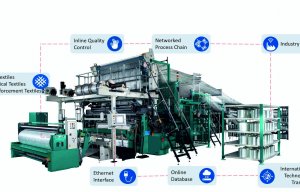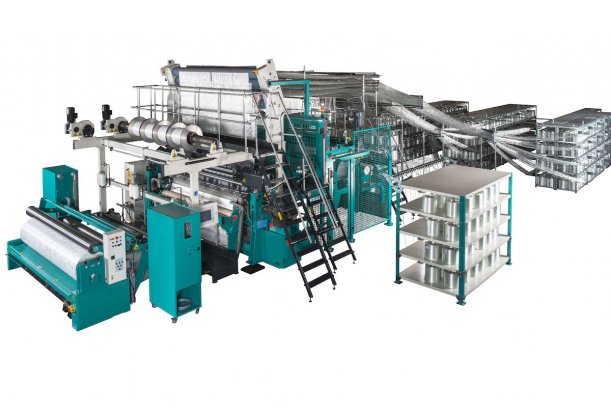
ITA targets concrete reinforcements with Karl Mayer BIAXTRONIC CO
Karl Mayer’s new Biaxtronic CO has been installed at the ITA, RWTH Aachen University for the development of innovative semi-finished fibre products.

10th February 2021
Knitting Industry
|
Aachen Germany
Textile reinforcements in concrete do not require any corrosion-related covering and thus make building cheaper, more environmentally friendly and more versatile, reports multiaxial warp knitting machine builder Karl Mayer. Completely new architectural solutions can be implemented through the slender construction forms of textile concrete, the company adds.
In this respect, the Institute for Textile Technology (ITA) at the RWTH Aachen University is investigating what is actually possible. Between 1999 and 2011, the Construction Composites Research Group developed textile reinforcement structures for concrete structures as part of the Collaborative Research Centre 532. The work was carried out on a Karl Mayer Malimo machine, and then continued at the ITA after 2011.
Recent textile projects placed high demands on machine technology and required new investments, Karl Mayer explains. Once again, the ITA opted for a model from Karl Mayer.

“The Malimo was already a great machine. Unfortunately, it was just getting on a bit,” says Martin Scheurer from the Department of Textile Machinery and ITA, when explaining their choice. He and his colleagues also valued Karl Mayer as a competent partner when it came to questions and service, the company says. They are now excited about the newcomer: a Biaxtronic CO was delivered to Aachen at the end of 2020, it adds. It had been completely assembled and functionally tested in advance at Karl Mayer Technische Textilien in Chemnitz, since it is a tailor-made model. The high-performance warp knitting machine with course-oriented weft-insertion was equipped with novel functions that will open up new research paths for the ITA and its research partners.
A made-to-measure model
Biaxtronic Co is predestined for the production of biaxial non-crimp fabrics and composite structures and was equipped with specific features for its use at the ITA. One of these is KAMCOS 2, the latest generation of Karl Mayer’s Command System, which offers an ethernet interface for integrating the machine into an existing network. This enables participation in future-oriented research topics such as Industry 4.0, inline quality control, sociology and process chain networking.
“We are planning to transmit the data from the producing machine via ethernet to the Internet of Production Excellence Cluster at RWTH Aachen University. The cluster deals with production research in high-wage countries,” explains Martin Scheurer.
The Biaxtronic CO for the research facility was also equipped with an EL pattern drive. Electronic guide bar control and the ability to vary process parameters inline contribute to the production of locally adapted, tailor-made textiles. What’s more, Karl Mayer says, the product quality can also be significantly improved. For example, Martin Scheurer wants to use the EL drive to investigate the influence of the warp knitting thread in different lapping variants on the geometry of the roving used and thus on the behaviour of the finished grid structure. Other details that favoured the Biaxtronic CO are a working width that meets standard industrial practices and the possibility of feeding basic substrates such as nonwovens in a standard process.
Research- and practice-based projects
With Biaxtronic CO, ITA researchers want to further develop and produce reinforcement structures for concrete matrices in particular. Functional models and prototypes for other areas of application are also to be produced on the machine. Martin Scheurer and his team want to produce reinforcements for wound dressings and hybrid warp knitted fabrics on a nonwoven substrate, for example. The combination of grid structures with other materials facilitates fundamental research into geotextile applications.
Projects for filtration technology can also be implemented. The production of unidirectional (UD) non-crimp fabrics for fibre composites and of flat warp knitted fabrics for heating textiles, which can be used in the mobility sector, are also conceivable, Karl Mayer says.
In addition to research and development work, the ITA has its sights set on production practice using the Biaxtronic CO. Users of weft-insertion machines can use the capacities and expertise in Aachen to optimise their production processes, produce prototypes of new textile structures or even test the processing of new materials.
Save the date: discovery awaits
Interested parties can find out what can be done with the Biaxtronic CO on 29 April 2021. To kick off the new year, the ITA invites you to discover the new machine as part of a one-day industrial event. “We look forward to exchanging information with industry and research partners from all over the world,” says Martin Scheurer. He is looking forward to stimulating discussions on the needs and future developments relating to companies in the manufacturing sector in particular.
Acknowledgements
The procurement of the Biaxtronic CO was funded by the German Research Foundation (DFG) and the State of North Rhine-Westphalia under project number INST 222/1264-1 FUGG. The ITA would like to thank the DFG and the State of North Rhine-Westphalia for their financial support. For further information please contact: [email protected].

Business intelligence for the fibre, textiles and apparel industries: technologies, innovations, markets, investments, trade policy, sourcing, strategy...
Find out more